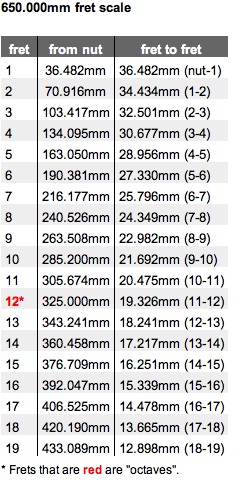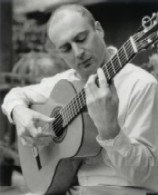Welcome to one of the most active flamenco sites on the Internet. Guests can read most posts but if you want to participate click here to register.
This site is dedicated to the memory of Paco de Lucía, Ron Mitchell, Guy Williams, Linda Elvira, Philip John Lee, Craig Eros, Ben Woods, David Serva and Tom Blackshear who went ahead of us.
We receive 12,200 visitors a month from 200 countries and 1.7 million page impressions a year. To advertise on this site please contact us.
|

|
|
How bridge is removed?!
|
You are logged in as Guest
|
|
Users viewing this topic: none
|
|
Login  | |
|

   
estebanana
Posts: 9351
Joined: Oct. 16 2009

|
 RE: How bridge is removed?! (in reply to Ahmed Flamenco) RE: How bridge is removed?! (in reply to Ahmed Flamenco)
|
|
|
For those who read along, this is a site with a fret - scale calculator
http://www.stewmac.com/fretcalculator
Go calculate 650 and then compare your scale carefully fret by fret. The best way to do that is get a meter ruler made of metal that has the Zero End square and cut flush with 0 mm. Then clamp the 0 end firmly against the nut, make sure the nut is pushed firmly against the finger board. The meter ruler should be indexed accurately and securely against the nut, showing the hash marks for measurement in the middle of the fret board.
Wear or use some type of magnification device to see the marks in relation to the frets. Use an exacto knife or other small blade as a pointer. Make sure you use the same eye each time if you close one eye or alway leave both eyes open when you check the fret position against the ruler. If you change eyes or open both eyes for some measurement checks you will experience visual phenomenon called 'Parallax'. Parallax means you are seeing past the object you are looking at in relation to the fixed point you are using to measure it because your point of vision has changed. Parallax creates enough distortion in your field of vision to allow for misplaced frets. So be aware of parallax when laying out index points that must be accurate to .00 mm's. I added further notes about parallax at the bottom of this post.
Check each fret position carefully, twice accounting for parallax and making sure the meter stick is secure. The 12th fret should be at 325.0 mm. If it is then check to see where the middle of the saddle is at the treble 'e' side and at the 'E' bass side.
I can't tell you, or any of us, can't tell you exactly where to put the middle of the saddle.
If you have the saddle at these following positions you will be close to getting good intonation provided your frets are in the correct positions. If this is the case instead of removing the bridge you may want to try to install a wider saddle, full 3mm wide type, and get more compensation value by filing the saddle edges forward toward the nut or back toward the tie block. You can widen the saddle slot by hand very carefully. Or fill it and re cut it with a hand saw and a scraper ground to 3mm wide.
You probably learn more and not have the same issue next guitar if you work with the saddle position and saddle edges until you get better intonation. But you must assure yourself you have ruled out compounding errors due to misplaced or unsecured ruler, and error due to parallax.
A good basic saddle location if frets are in place:
The middle of the saddle on the 'e' side at 651.50 mm
The middle of the saddle on the 'E' side at 652. mm

Make careful records on which frets an notes are out of tune or have poor intonation relative other notes. Then record if the chords in first position have difficulty playing between the C chord and E chord in relation to the intonation of the G string. If the G string feels sharp you can compensate it flatter in isolation from the other strings by filing the area under the G string back toward the tie block. This usually helps average out the differential in "Cents" between the two chords.
You are trying to average out the intonation not make one part perfect and the other parts sharp or flat. So you have to keep averaging out in your mind as you compensate it is a game of give and take.
Another possibility is to shave the nut end of the fingerboard by .4 or .5 mm which brings the nut .4 to .5 mm closer to the saddle, but I would not experiment with that until you exhaust the possibility of saddle compensation. There are different concepts about how to achieve good or almost total averaging intonation, but the most fundamental way is to work with accurate frets and move the saddle.
Later you may want to investigate compensated nuts, and other systems, but you should be able to come out with a good average intonation by saddle work. A book that gives a historical overview of Temperament and really gives some good conceptual insights is 'Lutes,Viols and Temperaments ' It will not solve your compensation issues alone but it will tell you why we arrived at Equal Temperament and what it means. It also explains Temperament systems that were used in the past and what faults they have when trying to play in all keys. This is not essential, to understand but knowing about past systems of temperament give a framework for why we want to use Equal Temperament today. It's fun to know that stuff. For example in Mozarts time they tuned the Fortepiano to create a different feeling on emphasis on the resolution of the IV and V chords back to the tonic. The intonation 'stresses' were modulated through tuning to give certain chords more or less weight in terms of intonation. Composers in different time periods wrote cadences in different ways and to bring that cadence to its full feeling or resolution the temperament played a part. Again it was a game of give and take making some chords sharper or flatter in relation to the tonic. Today we shoot for equal relationships in how chords are stressed in relation to the tonic. In means the system is imperfect and that we have to average out intonation as best we can.
http://books.google.co.jp/books/about/Lutes_Viols_and_Temperaments.html?id=oXE5AAAAIAAJ&redir_esc=y
You can also download it but it costs $36.00- It's probably better to have the book http://www.jstor.org/discover/10.2307/735907?sid=21105866687701&uid=70&uid=2129&uid=4&uid=2
You may also want to research into John Gilbert's work with compensation and also Greg Byers' work on compensated nuts. Both researches involve interesting math if you are into that.
One more thing about Parallax and rulers from Wiki:
'Parallax error in measurement instruments'
The correct line of sight needs to be used to avoid parallax error.
***Measurements made by viewing the position of some marker relative to something to be measured are subject to parallax error if the marker is some distance away from the object of measurement and not viewed from the correct position. ***
**For example, if measuring the distance between two ticks on a line with a ruler marked on its top surface, the thickness of the ruler will separate its markings from the ticks. If viewed from a position not exactly perpendicular to the ruler, the apparent position will shift and the reading will be less accurate than the ruler is capable of.***
______________________________________
Good accurate metal meter sticks are not really thin, so sight directly over the tick marks with the same eye every time.
This may seem didactic and terribly overbearing, but if we are going to have a conversation you have to make sure you rule out all possibility of measurement error, otherwise any help you get from me or others about compensation will not work.
Good luck!
Images are resized automatically to a maximum width of 800px
 Attachment (1) Attachment (1)
_____________________________
https://www.stephenfaulkguitars.com
|
|
|
|
REPORT THIS POST AS INAPPROPRIATE |
Date Apr. 3 2015 1:06:56
 |
|
 New Messages New Messages |
 No New Messages No New Messages |
 Hot Topic w/ New Messages Hot Topic w/ New Messages |
 Hot Topic w/o New Messages Hot Topic w/o New Messages |
 Locked w/ New Messages Locked w/ New Messages |
 Locked w/o New Messages Locked w/o New Messages |
|
 Post New Thread
Post New Thread
 Reply to Message
Reply to Message
 Post New Poll
Post New Poll
 Submit Vote
Submit Vote
 Delete My Own Post
Delete My Own Post
 Delete My Own Thread
Delete My Own Thread
 Rate Posts
Rate Posts
|
|
|
Forum Software powered by ASP Playground Advanced Edition 2.0.5
Copyright © 2000 - 2003 ASPPlayground.NET |
0.0625 secs.
|


 Printable Version
Printable Version










 New Messages
New Messages No New Messages
No New Messages Hot Topic w/ New Messages
Hot Topic w/ New Messages Hot Topic w/o New Messages
Hot Topic w/o New Messages Locked w/ New Messages
Locked w/ New Messages Locked w/o New Messages
Locked w/o New Messages Post New Thread
Post New Thread